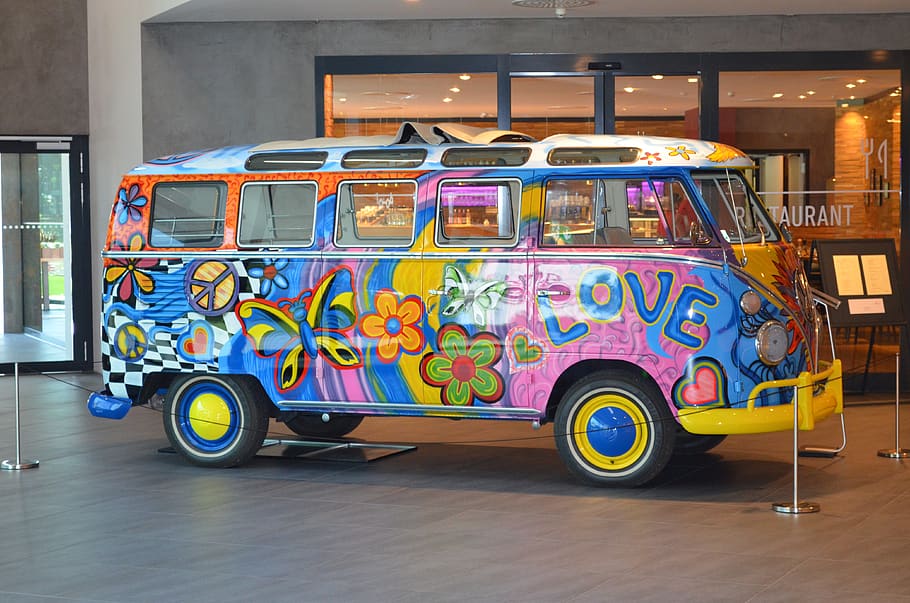VW Bus - a symbol of the counterculture to a portal into the future
Tracing the colorful journey of the VW Microbus through time
 Hippie van or bus because it was used to transport groups of young people with their camping gear and supplies to concerts and much later to anti-war rallies.
Hippie van or bus because it was used to transport groups of young people with their camping gear and supplies to concerts and much later to anti-war rallies.March 8, 1950. That was when the VW bus (known as the Type 2 then - Type 1 was the Beetle) first went into production. This was only VW's second product after the Beetle. Soon, it became a popular mode of transportation for hippies and became one of the first symbols of the counterculture movement.
The brainchild of a Dutch businessman, Ben Pon, the Microbus was sketched out as a concept in 1947. Volkswagen engineers then got to work in seeing it through to production and in 1950, the Type 2 with its boxy, utilitarian form was born. Famously known as the 'Combi' or 'Bulli' it was referred to by some as a hippie van or bus because it was used to transport groups of young people with their camping gear and supplies to concerts and much later to anti-war rallies. Some owners painted art on their buses and often replaced the VW logo on the front with the symbol for nuclear disarmament.
 Volkswagen engineers then got to work in seeing it through to production and in 1950, the Type 2 with its boxy, utilitarian form was born.
Volkswagen engineers then got to work in seeing it through to production and in 1950, the Type 2 with its boxy, utilitarian form was born.The Bus was the second product offering for Volkswagen, a company whose history dates back to.... erm Hitler. In 1933, he became chancellor of Germany and announced his plans to build affordable cars for the German people. Austrian-born engineer Ferdinand Porsche was already working on a small car. Hitler and Porsche went on to meet and the engineer was charged with designing the inexpensive, mass-produced Volkswagen translating to “people’s car”. In 1938, work began on the Volkswagen factory, located in present-day Wolfsburg and after the World War, full-scale production commenced starting with the Beetle and eventually the Bus. Initially, when the brand arrived in the USA in the 1950's, its Hitler connection and it's odd, unusual shape proved to be stumbling blocks. But then, Americans warmed upto it and by the 1970s, the Beetle was the world's best selling car with more than 15 million units sold.
In 1995, when the Grateful Dead's frontman Jerry Garcia passed away, VW ran an ad with a tear streaming down from a headlight of a VW Microbus. It was an acknowledgment of the role the Bus had played during the economic and cultural upheaval of the 60s. Quite unintentionally, Volkswagen, a brand that focused on making small, practical and affordable cars in the aftermath of World War 2 had become a symbol of rebellion and growing discontent among people - especially in the US.
 The Bus was the second product offering for Volkswagen, a company whose history dates back to.... erm Hitler.
The Bus was the second product offering for Volkswagen, a company whose history dates back to.... erm Hitler. It was easy to understand why, it stood out as a sore thumb in a crowd of overpowered, inefficient cars of the time that were spurred on by cheap gas. More importantly, it looked innocuous, cute even. Millions were sold and millions of peace signs and flowers found their way on them.
A combined 369 horsepower from two motors, a retro-modern design and new-age materials on the inside. The I.D. Buzz is eons ahead of the Microbus with 30 horses that debuted in 1950.
The hippie days too are way past us. But in a certain sense the I.D. Buzz, the Microbus' spiritual successor, is bringing the 60s' cry for equality and concern for the environment in to the future. The fringe thoughts of the 60s are now mainstream ideas and Yes, the I.D. Buzz might not get painted on, but ,with its all-electric drivetrain, and unmistakable shape comes across as the perfect vehicle to make a statement
 The I.D. Buzz will be expensive when it does arrive in 2022.
The I.D. Buzz will be expensive when it does arrive in 2022. VW could have chosen a number of different shapes for a new electric car, and crucially, the microbus is not even a popular form factor anymore. But the fact that VW did it, underlines two things - VW wants the design with the electric drivetrain to communicate that electrics will be the company's focus going forward; and even though the Microbus wasn't intended to be a symbol of the counterculture movement, VW acknowledges its influence on mainstream society and the electric motor fits the bill perfectly, for how could a successor to the Microbus be a fuel guzzler?
The I.D. Buzz will be expensive when it does arrive in 2022. Also, we are not in the 60s anymore and the I.D. Buzz no longer will be a protest vehicle for the masses. But, more importantly, it could still find itself in places where it makes an impact. Any guesses on how many eco-conscious celebrities will roll up to the red carpet in one?


